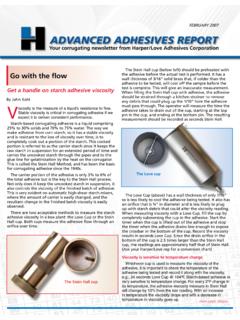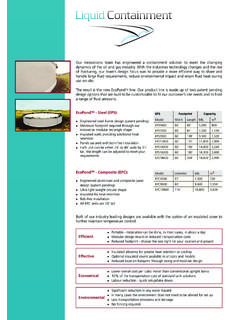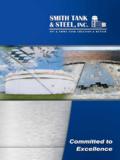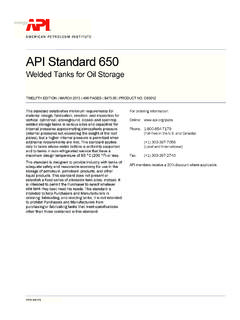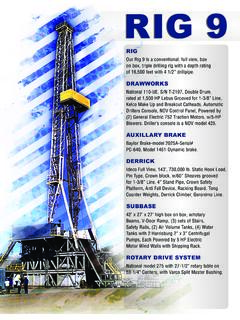Transcription of The good. The bad. The merely annoying.
1 Look first to the equipment!In the event of a problem, especially one that occurs frequently, the first place to lookfor a cause is the system s alarmdata base. Here you will find anentry every time an alarm is generated. Normally, the entriesare routine, such as, Batchfinished for inspection. Entriesthat flag a fault, such as, Watervalve did not close, or Starchblower on too long, will either tellyou exactly what s wrong or atleast direct your search in theYour corrugating adhesives newsletter from Harper/Love Adhesives CorporationADVANCEDADHESIVESREPORTA pril 2000 High-shear mixers: The good. The bad. The merely Lou CucciaOne of the greatest advancements in starchadhesive mixing equipmenthas been the introduction of thehigh-shear mixer. This sophisticated piece of equipmenthas reduced batch time and eliminated the need to store largequantities of starch. It speedsstart-up by allowing fresh adhesive to be produced quickly,and blended with low levels ofexisting stored starch starch adhesive deliversmore reliable viscosity, temperatureand gel points, resulting in consistent pick-up and transferfrom the glue roll to the flute are some older two-tanksystems still in use, but mostnewer high-shear systems aresingle-tank setups.
2 Both produceexcellent results, but the single-tank systems are faster,take up less space, and requireless energy than the two-tank systems. The accuracy and repeatability of the newer systemsare either case, operators needto pay close attention to theequipment, the formula, procedures and raw materials tomaintain consistent to find and fix common direction. Check your database for the past 30 days; youmay discover a maintenance and calibration of scales, temperaturegauges and other control components will keep them fromcausing it be the formula?A common problem with high-shear systems is increasingviscosity of adhesive in starch is put under highshear, it shears down quickly. Buta batch that finished at 32 to 34 Stein-Hall seconds at 105 F canrise to 40 or 42 S. H. in running viscosity is moreimportant than batch viscosity, thisis a phenomenon that must beanticipated in the starch sits with little or noagitation, it has a characteristiccalled dilatancy, which causes itto behave like quicksand.
3 Sincestarch granules are attracted toeach other, the mixture will thicken with time. To test how abatch will behave in storage, simply turn off the mixer and let itstand for 30 minutes. Check viscosity and temperature every10 minutes. When viscosity stopsincreasing, you will see yourworst-case scenario in amount of viscosityincrease or set-back is directlyrelated to the pounds of carrier(next page, please)which can change the amount ofcaustic soda delivered. Be surethat all supply lines are insulated, particularly those fromany storage system to the starchpreparation area. This line is afrequent cause of caustic delivery variation. If you suspect a new deliveryof caustic is causing viscosityand gel-point changes, you canmeasure the percent solidsusing a calibrated percent caustic soda has aspecific gravity of at 68 F. Finally, be sure you are receiving the correct the color of the bags andbe aware of this when materialis received.
4 Five mol boraxcomes in a purple or red mol comes in a green acid comes in an orangebag. Bag labeling will identify 5mol borax as pentahydrate, and10 mol borax as borax issue is theborax hopper chute. Be surethe hopper chute is checked andcleaned every day. The starchsystem program may tell youthat all the borax was discharged but it may be sittingunused in the supply in the formula. Morestarch will increase viscosity set-back in storage. Less starchwill decrease viscosity set-back in storage. What about those raw materials?Sometimes, a new lot of pearl,caustic, or borax can be differentenough to create problems. It s agood idea to chart your supplierCOAs (Certificates of Analysis) soyou ll know when new materialsdiffer significantly from the onesyou ve been using. It s also wise to do your ownstarch moisture and caustic sensitivity tests when you receivea new lot of starch.
5 These willhelp you spot variations thatdirectly affect viscosity and gelpoint. Usually, you can adjust theamount of caustic soda in yourbatch to bring viscosity and gelpoint back in line without affectingcorrugator performance. (ContactHarper/Love for test procedures.)If you re using 50% liquid caustic, remember it freezes at53 F. Your tanks must be heated, and should also employ acirculation or agitation system tokeep the contents from settlingout. As caustic soda approachesfreezing point, crystals are formedRemembering Conley EllisHigh-shear mixers, continuedOh, that pesky starch build-up!If you find that batch viscosityincreases as the day proceedsyou are probably experiencingbuild-up of starch on the side ofthe tank (or a steam leak). In asingle-tank mix, any build-up thatis left in the mixer at the end ofthe batch becomes additional carrier in the next batch. Sincethe system zeroes itself, thisbuild-up is ignored by the sure your high-shear tanks are clean to avoid growing batch weights tell the good troubleshootingguide is to chart the final batchweight.
6 This is the total indicatorthat everything went into thebatch as programmed. The newhigh-shear systems are extremelyaccurate, so swings in the totalbatch weight are a reliableindicator that something is not take it one step at a down viscosity and gel-point problems is a lot lessfrustrating if you keep goodrecords and check out one thingat a time in a logical order. Good hunting. Let us know if wecan s Conley Ellis diedFebruary 4. His loss is felt deeply byhis friends and colleagues in the corrugating began in the industry in theearly 1950s and progressed from operator to foreman, to plant superintendent before joiningHarper/Love as a technical sales andservice representative in August of was most recently technical servicemanager for our Northeast Region. Says Regional Manager Bill Gerard, Conley always put the customer believed doing the right thing isalways good business.
7 Conley was alsoa strong team player, who took pleasurein the success of others. We ll miss him. Bill Gerard (left), remembers Conley Ellisas a team player with a strong ethic ofcustomer service. Conley provided technical service to Harper/Love customers in the Northeast Region fromhis home in Elizabethton, Clabo and Alan Harris haverecently joined Harper/Love toexpand sales and technicalcoverage in the Southeast and will be based in Tennesseeto provide technical services to agrowing customer base in theSoutheast. He has over 20 years experience in corrugator operations. He began his careerwith Westvaco and most recentlywas corrugator superintendent foranother large integrated staff additionsQuick tip: SolvingSesame tape blistersSome of our customers haveencountered a blistering problem when using 2 reinforced Sesame tape applied between the lower liner and the web.
8 The problem appears to be caused by insufficient temperature and pressure. The tape needs to reach atleast 215 F to melt the adhesive. Greater load pressure has over 8 years experience providing adhesiveand service to the industrial packaging and corrugating market. He also has deep experience with both AnheuserBusch and Coors in sales andmarketing. Alan will be based inthe Kansas City, Missouri, area,with responsibility for sales and technical Clabo (left) and Alan Harris (right) inHarper/Love s laboratory to consider thefiner points of starch adhesive formulationwith Lou Cuccia, southern regional liners offer the benefit ofgreater strength with less weight,but the compressed fibers andharder finish make it more difficultto get a good bond. Compared to standard liners,HRC materials resist moistureabsorption. Starch tends toremain on the surface. They alsotransfer heat faster causing thestarch gel point to occur too earlyfor proper wetting out.
9 The resultis a shallow, brittle liners tend to resist moistureabsorption, making it difficult to obtain agood are a few things that willhelp you accomplish a betterbond with HRC liners:Also, make sure your singlefacer is in good operating condition and that proper settings are Adhesives willsoon introduce a new productdesigned specifically to providesuperior bonding at higher speedswith HRC with high ring crush liners Higher a highersolids carrier. Increase overalladhesive solids to 26 to 30 percent. Lower viscosity. Try 30 to 40 Stein-Hall seconds. Less the heatgoing into the glue mechanism toabout 200 F to 210 F. Increase gap gap to about .002 more thanregular board. Higher speed. Run as fast asyou can without THIS ISSUE Troubleshooting high-shear mixers Remembering Conley Ellis New reps in Southeast and Midwest Working with high ring crush liners Solving Sesame tape blistersYour corrugating adhesives newsletter from Harper/Love Adhesives CorporationADVANCEDADHESIVESREPORTH arper/Love Adhesives Corporation11101 Westlake Box 410408 Charlotte, North Carolina 28241-0408800-438-3066 Leaders in the science ofmaking good adhesives better : 599 Hydratite 599 is a second-generation liquid polyphenolic resin.
10 It combinesthe technology of Hydratite 550 with new crosslinking products to yield a production tool with a greater range of wetstrength potential. The polyphenolic andketone blends react more aggressively toform permanent crosslinks. This high-performance polyphenolic resinenhances wet strength properties and bondformation. Contact your Harper/Love representative for application performance resin Accelerates glue line dehydration Drier, firmer, flatter board Enhanced downstream efficiency Cross-linking capability improves wet strength Easy to use liquid Compatible with automatic starch kitchens Very safe to use Distinctive color for visual assurance of us
